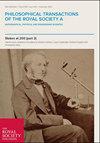有限维接触力学
Philosophical Transactions of the Royal Society of London. Series A, Mathematical and Physical Sciences
Pub Date : 2001-12-15
DOI:10.1098/rsta.2001.0904
引用次数: 25
摘要
本文描述了最近发展的基于测量微分包含和时间步进方法的刚体动力学的连续和数值公式,并将其扩展到包括有限数量的弹性振动模态。时间步进方法已经包含了库仑摩擦,并且能够处理一些情况,例如PainlevÉ的著名问题,其中脉冲力发生而没有碰撞。振动的弹性模态可以直接纳入连续公式,但由于弹性振动的典型刚度,需要修改所使用的数值方法以直接纳入它们。所得的数值方法在极限情况下是耗散的,但只在有接触时耗散能量。本文章由计算机程序翻译,如有差异,请以英文原文为准。
Finite-dimensional contact mechanics
In this paper, the continuous and numerical formulations of rigid–body dynamics based on measure differential inclusions and time–stepping methods recently developed are described and extended to include a finite number of elastic modes of vibration. The time-stepping methods already incorporate Coulomb friction, and are able to handle situations such as PainlevÉ's famous problem where impulsive forces occur without a collision. The elastic modes of vibration can be incorporated directly into the continuous formulation, but due to the stiffness typical of elastic vibrations, the numerical methods used need to be modified to incorporate them directly. The resulting numerical methods are dissipative in the limit, but only dissipate energy while there is contact.
求助全文
通过发布文献求助,成功后即可免费获取论文全文。
去求助
来源期刊
自引率
0.00%
发文量
0

 求助内容:
求助内容: 应助结果提醒方式:
应助结果提醒方式:


